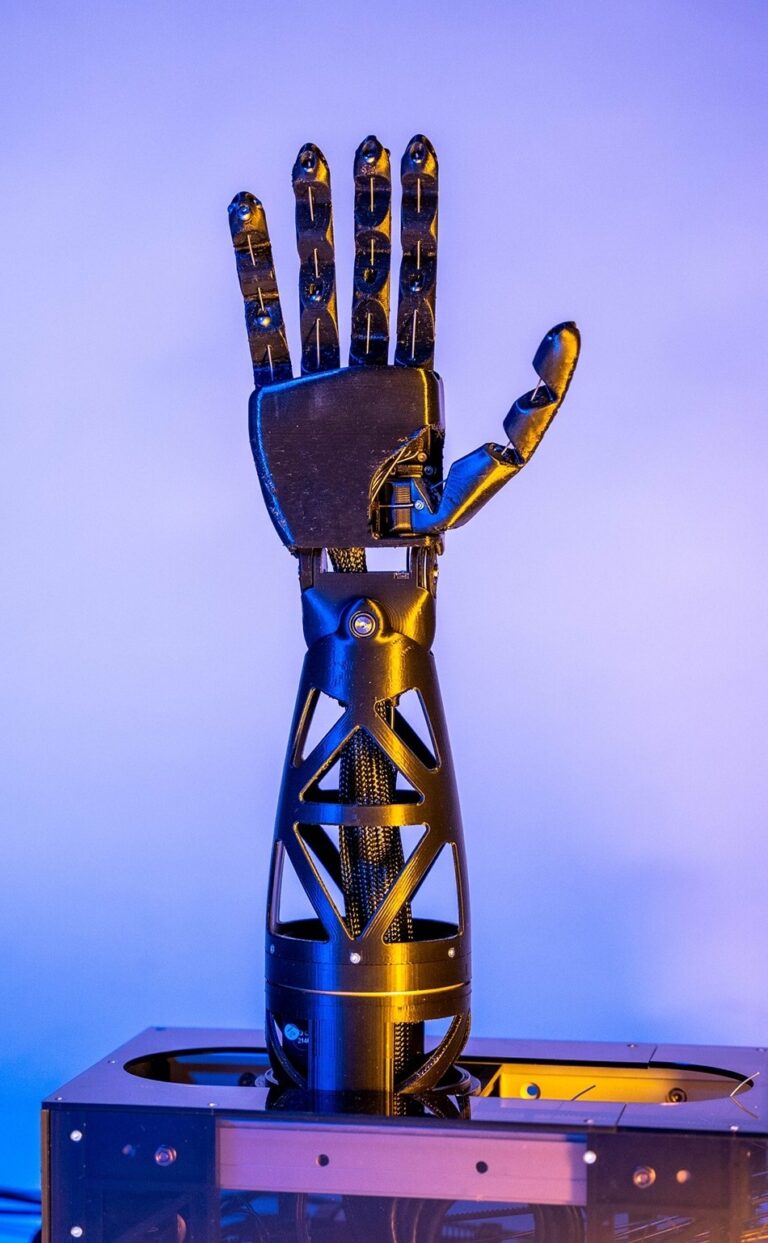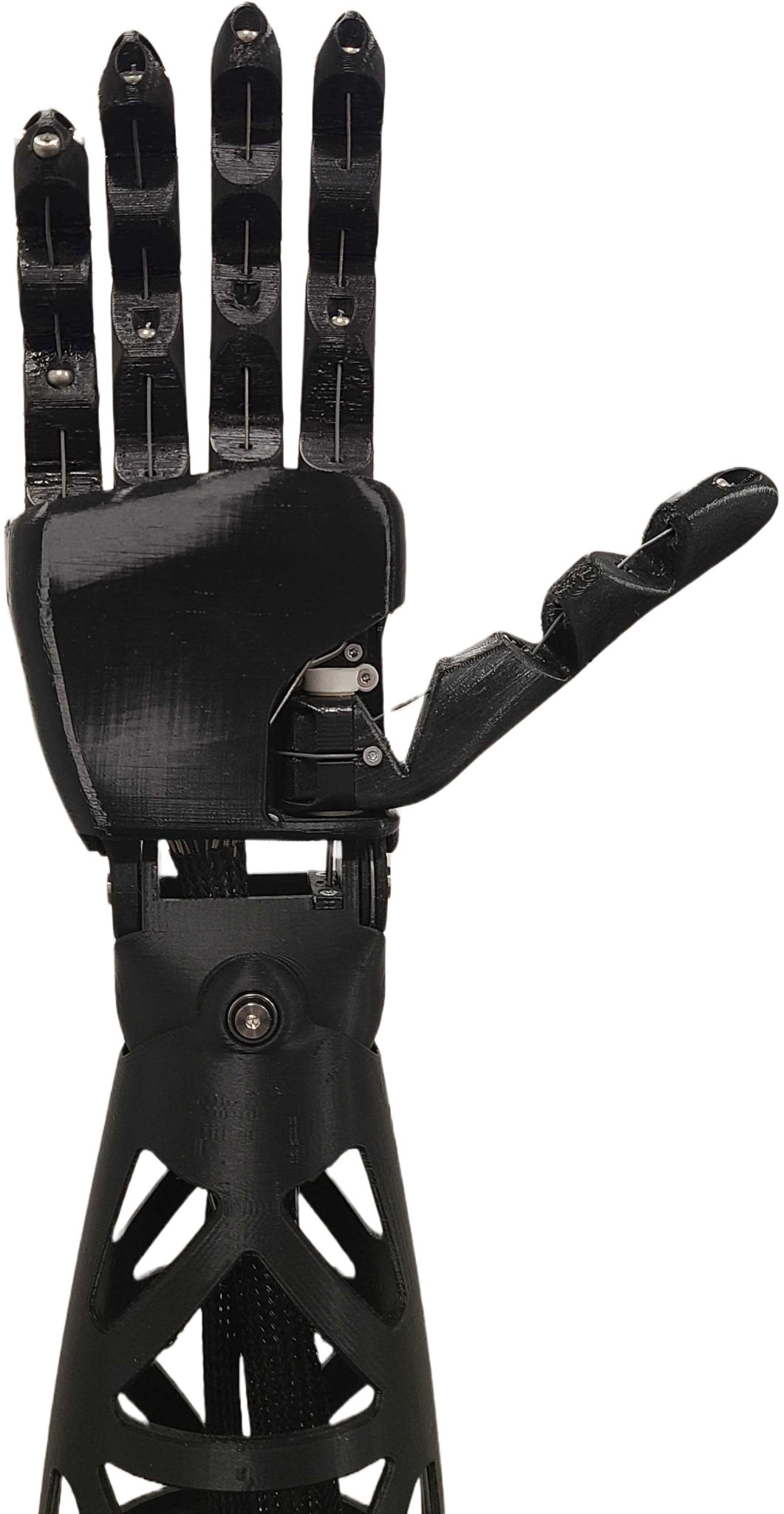The Tatum T1

The Tatum T1
Providing newfound freedom and privacy, the Tatum T1 is a robotic system that outputs natural tactile sign from mainstream communication media. Disrupting the field centered on braille, the T1 has been designed to incorporate and showcase signing culture.
Human-Centered Hardware
Taking Collaborative to the Next Level
The T1 Fingerspelling Hand is a novel, humanoid armature system. Designed to optimize dexterity and compliance, the T1 Fingerspelling Hand features 18 Degrees of Freedom while remaining anthropomorphic in size, shape, and feel.
Opening Up the World of Resources
First, the device will sign based on live text or voice input. Secondly, the device can sign based on pulled data from communication mediums (emails, websites, messenger, eBook). Lastly, the device can sign based on remote, real-time signing (similar to a traditional phone call relay.
specifications
To make sure the device signs true ASL, motion tracking is used to capture signs from native, Deaf, and DeafBlind signers and then mapped to the T1.
To achieve 18 Degrees of Freedom while still maintaining an anthropomorphic size, Tendons are coupled to remote actuators creating fluid and dynamic movements.
Signing requires more than just fingerspelling. To achieve all signs in ASL, the T1 fingerspelling hand will be integrated in our Tatum Arm for complex signing.
Since some users have some vision, different colors coverings can prove more helpful – whether that be light or dark for contrast and shadowing.
Since the DeafBlind users will have their hands along the back profile of the device, traditional linkage designs would cause gapping where user’s fingers could get caught during flexion and extension. Instead, a smooth profile is achieved with a continuous surface.
In order to achieve all handshapes, the wrist needs to achieve flexion, abduction, and rotation. Since some tactile users track the device by holding onto the wrist, the design of the wrist must too be human-like.
Safety is our number one priority at Tatum Robotics. Using all flexible materials where the user will contact the device ensures that under no circumstance will the DeafBlind user be put in harm’s way.

Software
Teaching a Robot to Sign
Tatum has developed the first translation algorithm that turns English text into ASL. By determining custom morphosyntax parsing standards for both English and ASL, we can accurately and repeatedly translate written English into grammatically sound ASL. Importantly, our parsing standards allow us to capture the regional and demographic differences of signers to allow for ease of use.
How Tatum Translate Works
“I will call you after I drive home”
Tatum Translate downloads English text from any digital medium.
1SG.SUBJ will.AUX.1SG.FUT call.U 2SG.DOBJ after 1SG.SUBJ drive.1SG.PRES home.
To separate words that look the same in English but have different signs, we gloss English to expose morphemes that will distinguish between these tricky English words with multiple meanings. For example, the word “where” plays a different morphosyntactic role in each of the following three sentences, so our glossing process identifies them separately: “Where did you buy that hat?” “I don’t know where the party is going to be.” “The town where I grew up is near the ocean.” These sentences, when translated, would not treat the word “where” the same way, so our glossing process must make it clear which “where” is in the English sentence.
IX1 DRIVE HOME FINISH 1CALL2 FUTURE
Using hundreds of “if then” rules, Tatum Translate turns English phrases and words into ASL gloss. Consistent patterns in the linguistic landscapes of both languages enable accurate translation from one language to the other. Though this software was created for the Tatum device, as the first algorithm that can output ASL gloss from English, there are other areas where Tatum Translate’s capabilities may be relevant, too.
Lastly, the hardware executes the signs in the order that they appear in the gloss so they can be received by a tactile signer.
Linguists gloss languages in order to understand the components that make up each word, not just the overall meaning. These components are called morphemes, and each morpheme contributes a piece of information. Glossing exposes a language’s morphemes so that linguists can see how worlds are built. When people talk about glossing sign languages, they don’t mean exposing morphemes. ASL is a visual language with no written form that easily captures the visual component. Glossing ASL – writing down the signs using English terms for each sign – is the closest you can get to writing down the language.

